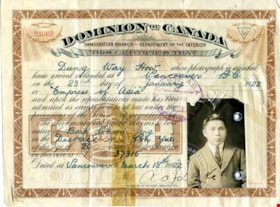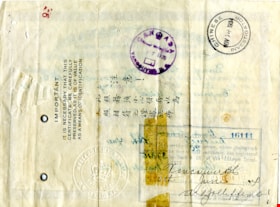Narrow Results By
Head tax certificate issued to Dung Way How
https://search.heritageburnaby.ca/link/museumdescription15546
- Repository
- Burnaby Village Museum
- Date
- 1922-1934 (date of original), copied 2021
- Collection/Fonds
- Burnaby Village Museum Document collection
- Description Level
- Item
- Physical Description
- 1 certificate (tiff) : col. ; 600 dpi
- Scope and Content
- Item consists of a head tax certificate issued by the Dominion of Canada - Immigration Branch - Department of the Interior to Dung Way How (Dong Howe). The certificate was first issued on March 18, 1922 and includes certification stamps on the front along with a photograph of Dung Way How. Certifi…
- Repository
- Burnaby Village Museum
- Collection/Fonds
- Burnaby Village Museum Document collection
- Description Level
- Item
- Physical Description
- 1 certificate (tiff) : col. ; 600 dpi
- Scope and Content
- Item consists of a head tax certificate issued by the Dominion of Canada - Immigration Branch - Department of the Interior to Dung Way How (Dong Howe). The certificate was first issued on March 18, 1922 and includes certification stamps on the front along with a photograph of Dung Way How. Certification stamps on the verso of the certificate were issued by Chinese Immigration authorities between 1922 and 1934. Information on the front of the certificate reads "...This Certifies That / Dung Way How whose photograph is attached / hereto arrived or landed at Vancouver B.C. / on the 23rd day of January 1922 / ex "Empress of Asia" / and upon representations made has been / admitted as exempt from head tax under the / provisions of the Chinese Immigration Act. / The above mentioned party claims / to be a native of Bark Choon Jong in the District of Pon Yue of the age of 20 years. The declaration in this case is C.I.4. No. 3715 Date at Vancouver on March 18, 1922" signed by "Controller of Chinese Immigration". Printed text on verso of certificate reads "IMPORTANT / IT IS NECESSARY THAT THIS / CERTIFICATE BE CAREFULLY / PRESERVED AS IT IS OF VALUE / AS A MEANS OF IDENTIFICATION".
- History
- Dung Way How (Dong Howe) arrived from Bak Chun (North Village), Guangdong in 1922 as a paper son. He had two sons during his first marriage, but the sons remained in China and one died at a young age. He married his second wife Chow Goon Pang through an arranged marriage. She was married twice previously and had a son from each marriage, but neither of them survived. Chow was from Nam Chun (South Village) and arrived in Canada as a paper daughter around the late 1930s or early 1940s. Both Dong and Chow spoke a Poon Yue dialect. The couple raised one daughter Vivian Dong (Dong Jing Yu) in Canada. The Dong family leased and operated the New Fountain hotel in Vancouver located at Abbott Street and Cordova Street. The family later went on to purchase farmland in Burnaby in 1957. The Dong family moved to Burnaby and operated a three acre market garden located at 6220 14th Avenue until 1972. They grew European staples including celery, radishes, green onions, beets, lettuces, endives, as well as Chinese vegetables such as gai lan (Chinese broccoli). There were two Chinese families in the area, including the Wong family who operated the Wong Chew market gardens 6325 14th Avenue. Dong Howe passed away in 1978. Chow Goon Pang passed away in 2000. Their daughter Vivian grew up in Burnaby and attended Riverside Elementary, McPherson Junior High School and Burnaby South Secondary School.
- Creator
- Government of Canada
- Names
- Howe, Dong
- Accession Code
- BV021.13.1
- Access Restriction
- No restrictions
- Reproduction Restriction
- No known restrictions
- Date
- 1922-1934 (date of original), copied 2021
- Media Type
- Textual Record
- Photograph
- Scan Resolution
- 600
- Scan Date
- March 25, 2021
- Scale
- 100
- Notes
- Title based on contents of photograph
Images
Oakalla Prison fonds
https://search.heritageburnaby.ca/link/archivedescription100561
- Repository
- City of Burnaby Archives
- Date
- 1911-1953
- Collection/Fonds
- Oakalla Prison fonds
- Description Level
- Fonds
- Physical Description
- 6 cm. of textual records.
- Scope and Content
- Fonds consists of records created by the Oakalla Prison Farm, including administrative correspondence related to staff appointments and wages, and a staff shortage when employees left to fight in World War I. The records pertain only to staffmembers of the prison and are not directly related to any…
- Repository
- City of Burnaby Archives
- Date
- 1911-1953
- Collection/Fonds
- Oakalla Prison fonds
- Physical Description
- 6 cm. of textual records.
- Description Level
- Fonds
- Record No.
- 66669
- Access Restriction
- No restrictions
- Reproduction Restriction
- No restrictions
- Accession Number
- 2022-13
- Scope and Content
- Fonds consists of records created by the Oakalla Prison Farm, including administrative correspondence related to staff appointments and wages, and a staff shortage when employees left to fight in World War I. The records pertain only to staffmembers of the prison and are not directly related to any prison inmates.
- History
- The Oakalla Prison Farm was a model prison farm on 185 acres (75 ha) of land next to Deer Lake, Burnaby. The Oakalla Prison Farm was a full-service facility that originally opened on September 2, 1912, and was initially designed to hold 150 men and women. The first inmate was William Daley, sentenced on July 31, 1912 to serve a year of hard labor for stealing some fountain pens valued at over $10. By April 30, 1913, some 328 prisoners had passed through the jail's doors. In 1916, the women's section officially opened, and in 1942, the women's unit opened on the grounds as a separate facility. It was renamed as the "Lakeside Correctional Centre for Women" in 1979. The original women's unit was expanded in 1953, and consisted of two cottage-style buildings. By the 1950s, the population was well over 1000. As a working farm, the prison had its own dairy, vegetable gardens, and livestock. Executions in British Columbia were primarily carried out in Oakalla; after 1919, it was the sole penitentiary where executions took place. The first execution was that of 25 year-old Alex Ignace on August 29, 1919. 44 prisoners were executed by hanging at Oakalla from 1919 until the death penalty was abolished in 1959. In 1959, the last execution in British Columbia took place at Oakalla, with the hanging of former sailor Leo Mantha, aged 33. Oakalla was also one of the locations that undertook the experiment of performing cosmetic surgery on inmates to remove deformities that made prisoners "more likely to offend". The experiment was led by Dr. Edward Lewison, and continued into the mid-1960s. Procedures were conducted on 450 inmates, voluntarily. In 1970, the prison was renamed as the Lower Mainland Regional Correctional Centre (LMRCC) The farm portion of the prison, providing work for the inmates and food in the prison, closed in 1979 and 64 acres of land were transferred to the City of Burnaby. This land was included in the existing Deer Lake Park that was adjacent to the prison. Originally designed to house a maximum of 484 prisoners, Oakalla's population peaked in 1962-1963 at 1,269 inmates. With population averages of over 600, overcrowding was always a problem. In the institution's final years, two nationally-spotlighted events occurred. 13 maximum security prisoners escaped on New Year's Day, 1988, following an uprising on December 27, 1987, and on November 22, 1983, a violent and costly riot took place. Rioters caused more than $150,000 damage in a two-day spree. Oakalla was closed down on June 30, 1991, and was developed into a new residential housing development and an expansion of the park. Prisoners from Oakalla were then moved to various other Correctional Facilities in British Columbia, including but not limited to the Vancouver Pretrial Services Centre (VPSC), the Fraser Regional Correctional Centre (FRCC), and the Alouette Regional Correctional Centre (ARCC), later Alouette Correctional Centre for Women. Source: https://wikimapia.org/8004045/Former-site-Lower-Mainland-Correctional-Centre-Oakalla-Prison-Farm Source: https://en.wikipedia.org/wiki/Oakalla_Prison
- Media Type
- Textual Record
Shore line
https://search.heritageburnaby.ca/link/museumdescription1398
- Repository
- Burnaby Village Museum
- Date
- [1936]
- Collection/Fonds
- Burnaby Village Museum Photograph collection
- Description Level
- Item
- Physical Description
- 1 photograph : sepia ; 5.5 x 8.5 cm
- Scope and Content
- Photograph of a shore line. There appears to be a fountain base in the water in the foreground. Along the shore, there are several large multi storey buildings (one of the buildings has a cupola). The note in the accession register speculates the area to be around the Lost Lagoon or the West End in…
- Repository
- Burnaby Village Museum
- Collection/Fonds
- Burnaby Village Museum Photograph collection
- Description Level
- Item
- Physical Description
- 1 photograph : sepia ; 5.5 x 8.5 cm
- Material Details
- inscribed in pencil, verso, u.l. "July 19"
- Faint circular stamp mark of "Vancouver Drug Co." on verso, and gummed paper on each corner. The stamp reads, "Come to Vancouver's Golden [illegible]/ 50 Years of Progress" outside its circular seal for "Vancouver Drug/ Co. Ltd./ Nu-Gloss/ PHOTO FINISH"
- Scope and Content
- Photograph of a shore line. There appears to be a fountain base in the water in the foreground. Along the shore, there are several large multi storey buildings (one of the buildings has a cupola). The note in the accession register speculates the area to be around the Lost Lagoon or the West End in Vancouver.
- Accession Code
- BV985.5772.1
- Access Restriction
- No restrictions
- Reproduction Restriction
- No known restrictions
- Date
- [1936]
- Media Type
- Photograph
- Scan Resolution
- 600
- Scan Date
- 2024-02-02
- Notes
- Title based on contents of photograph


![Shore line, [1936] thumbnail](/media/hpo/_Data/_BVM_Images/1985/198557720001.jpg?width=280)